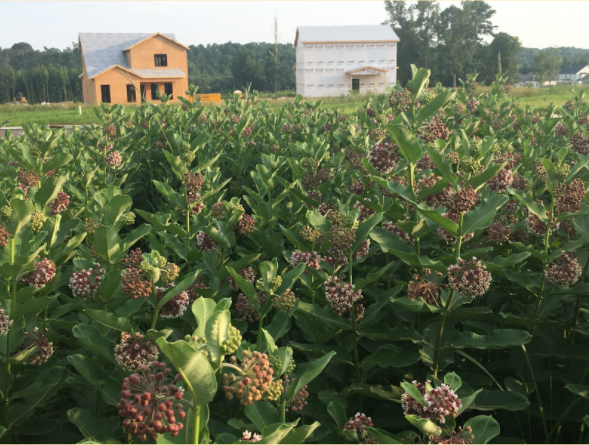Milkweed Plants & Monarch Butterflies: A Love Story

Milkweed & Monarchs
In honor of Valentine’s Day, 2022, we’re sharing a sappy story. It won’t cause your heart to flutter, but it may bring you fluttering monarch butterflies – which we think is way better!
The monarch butterfly (Danaus plexippus) floats at the top of North Carolina Wildlife Federation’s pollinator priorities. Along with other pollinators, it has been in severe decline due to habitat loss, misuse of pesticides and climate change. For monarchs and other pollinators to thrive, we must add a diversity of native plants to the landscape to restore suitable habitat.
Like other pollinators, the monarch butterfly relies on a single group of plants for reproduction: milkweed (Asclepias spp.). They are a group of flowering, herbaceous perennials with several species occurring in North Carolina. Milkweed grows in a variety of habitats – from prairies and open fields to riparians and swamps to sandhills and beach dunes.

NCWF Conservation Coordinator Madison Ohmen took this photo of a Milkweed patch under threat of expanding development.
Types of milkweed
There are about 16 species of milkweed that are native to North Carolina. The most well-known and easy-to-find species consist of common milkweed (Asclepias syriaca), butterfly weed (Asclepias tuberosa), swamp milkweed (Asclepias incarnata), and whorled milkweed (Asclepias verticillata).
Several species can be found at a handful of native plant nurseries; however, others are difficult to find in cultivation. While each milkweed species may vary in size, floral color and leaf shape, most milkweeds are characterized by the milky sap within their stems and their unique flower shape.
Milkweed plant overview
Each flower has five reflexed petals and five hood-and-horn structures, making the corona – an outgrowth of a flower. Their pollen is located under the hoods. Pollination occurs when pollinators slip their legs between the hoods and contact the hidden pollen. While some pollinators are strong enough to pull their legs out from between the hoods (ex. bumble bees), others are not as strong and may lose a limb or get stuck (ex. European Honey Bees). Milkweed flowers develop in clusters attracting many different insects from butterflies to bees to beetles and more. The color and size of the flowers are key identifying factors for each milkweed species.
Why are milkweed plants beneficial to pollinators?
We can all appreciate a sappy story and milkweed has a good one! Their stems and leaves hold a milky substance that contains cardenolides- making the sap toxic to humans and other wildlife species. Some species, however, have evolved to utilize the milky substance. Monarch butterflies solely rely on milkweed as their larval host plant. Caterpillars of the monarch eat the leaves and milky sap and store the toxins in their tissues, making them unpalatable to many predators.
Native plants provide floral and pollen resources to pollinators who rely on a diversity of native plants to meet their needs. Plant diversity is essential to provide pollinators with a variety of pollen resources, which increases nutrition availability and boosts pollinator immune systems. Plant diversity also caters to pollinator specialists – a type of pollinator who relies on a particular plant to reproduce, such as the monarch butterfly.
Where to buy and plant milkweed
Milkweed can be planted as seeds during the fall/winter or as plugs/containerized plants. To grow milkweed on your property, first research which types of milkweeds would be appropriate for your area. Check out NCWF’s list of nurseries to see if there are native milkweed selections near you for sale.
How to grow milkweed
- Milkweed seeds: Milkweed seeds must undergo a period of cold stratification, or a period of exposure to cold temperatures, in order to germinate. For this reason, it is best to plant your milkweed seeds in the fall so they can undergo cold stratification naturally. If you wish to plant in the spring, you can trick the seeds into germinating by placing the seeds in a baggie or tupperware on top of a moist paper towel or moist sand. Keep the seeds in the refrigerator for at least 30-40 days. After this period of time, they should be ready to grow in a pot or in the ground.
- Milkweed plants: It is important to plant your milkweed in garden conditions that are similar to its natural growing conditions. Swamp milkweed should be planted in moist or wet soils while butterfly weed or whorled milkweed should be planted in drier soils. They should also be planted in full sun and spaced at least 18 inches apart.
To learn more about how to grow milkweed, visit this resource.
NCWF efforts to increase and conserve pollinator habitat
Many populations of milkweed and other native plants are disappearing due to habitat loss, misuse of pesticides, climate change and lack of plant knowledge amongst the public. NCWF addresses these challenges through policy work and our Butterfly Highway program, a statewide initiative to increase and conserve pollinator habitat.
We’ve also partnered with other organizations through the North Carolina Pollinator Conservation Alliance to bring pollinator education, native plant resources and pollinator-friendly practices to the public.
Webinars, pollinator field days and native plantings are ramping up this year to support pollinator conservation and preserve iconic species like the monarch. We will also advocate for pollinator elevation in scoring for landowner cost-share, sources within the Farm Bill, Natural Resources Conservation Service funding and land acquisition priorities.
Sign up for our weekly Butterfly Highway newsletter for information about pollinators and native plants for your yard, where to buy them and updates on what’s flying and blooming across the state.

